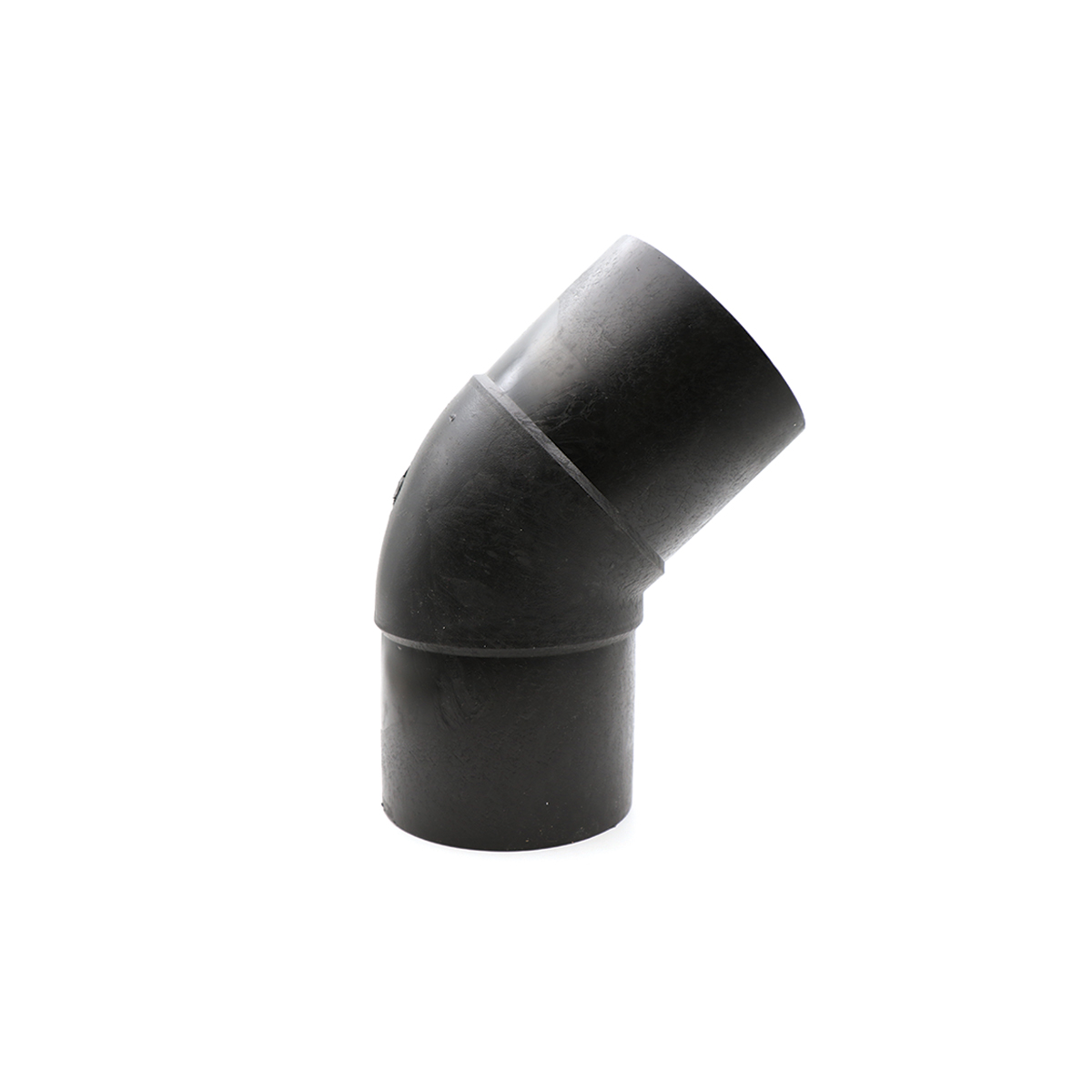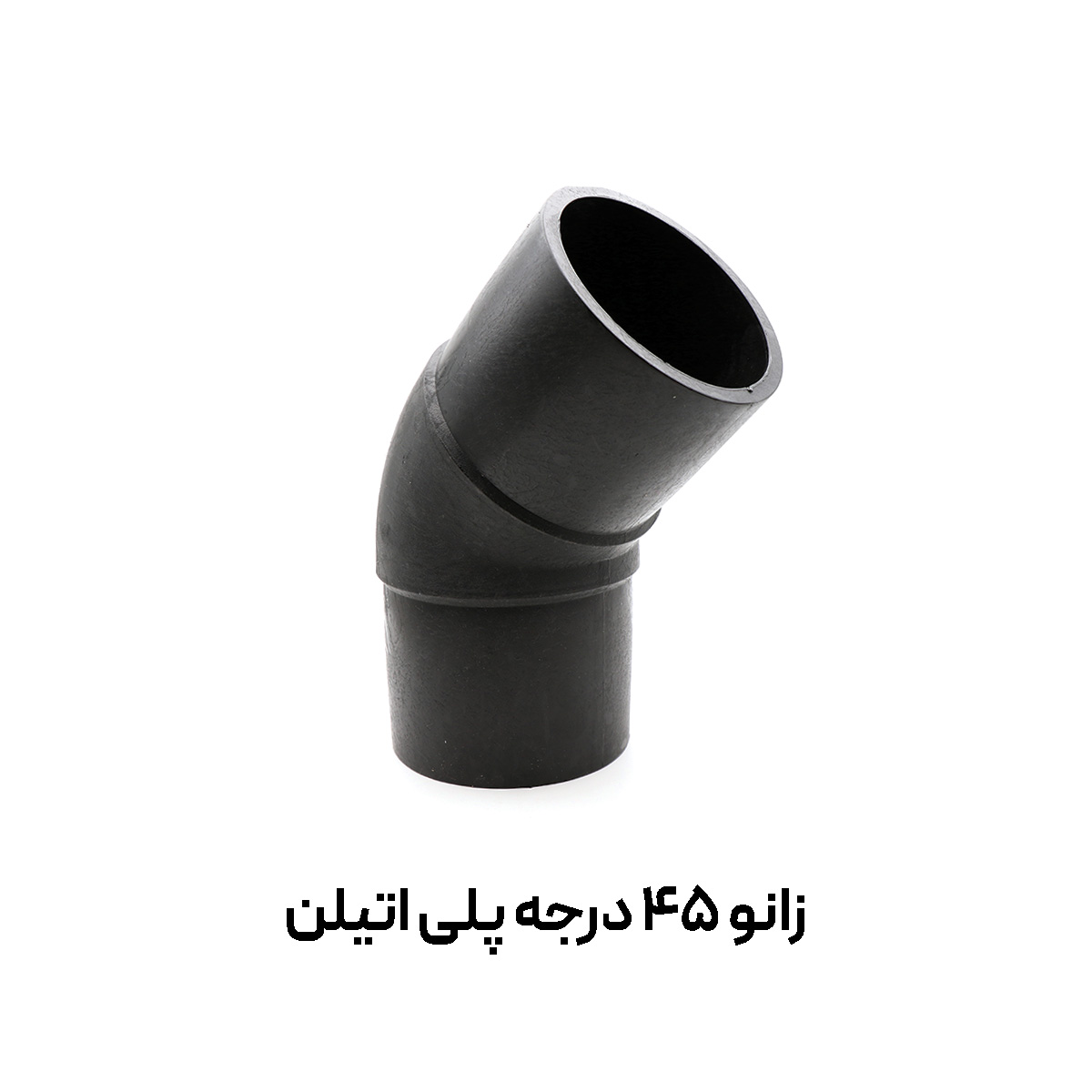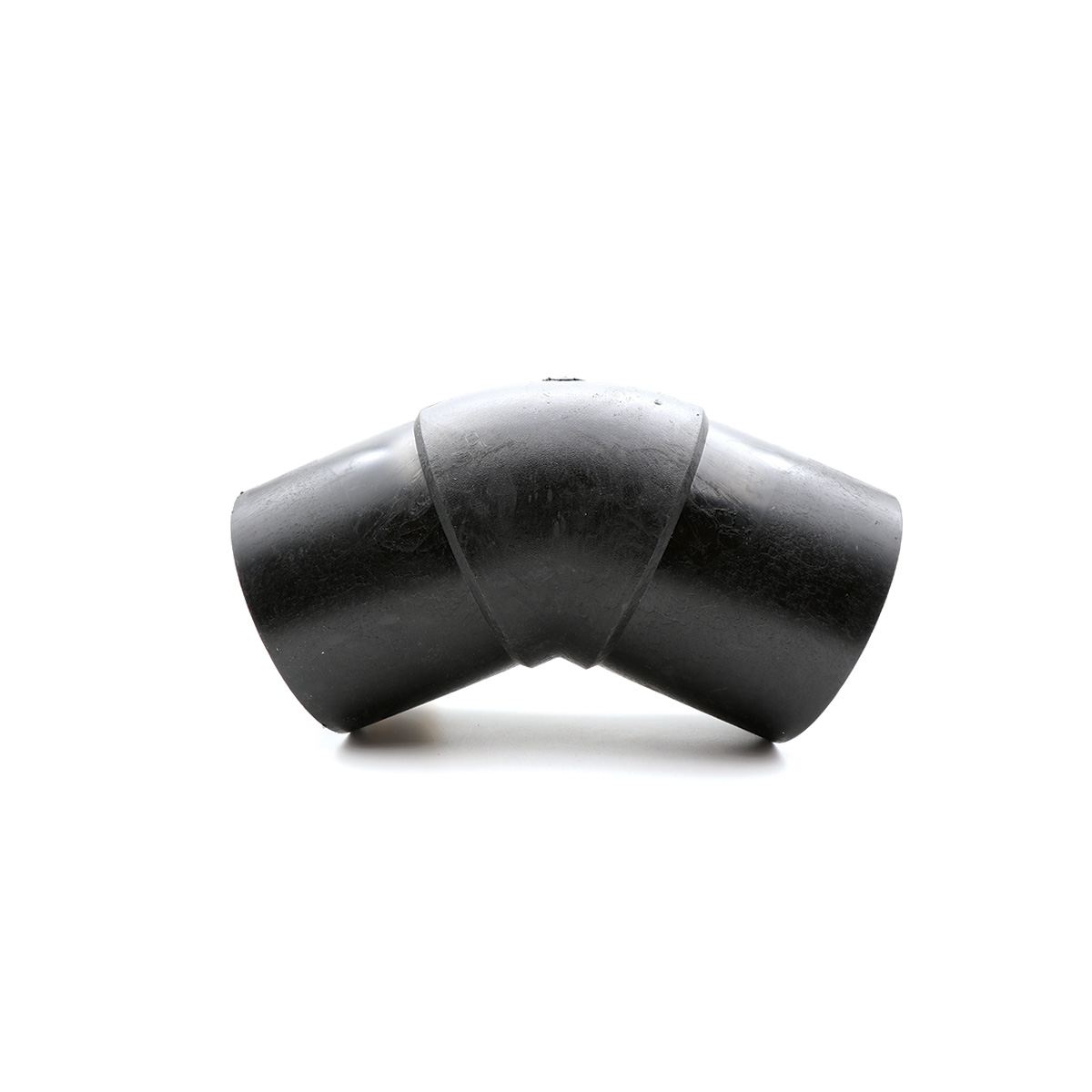A high-pressure 45° HDPE elbow is a precise, stable fitting for changing flow direction at a 45° angle. The body is made of high-density polyethylene (HDPE), resistant to UV radiation, cold, and corrosive environments, and is installed on pipelines by butt fusion. These elbows are offered in sizes from 40 to 400 mm, withstand working pressure up to 16 atmospheres, and are a reliable choice for water supply, wastewater, gas and oil transfer, and agricultural applications.
Technical Specifications and Key Features
- Joint angle: 45°
- Working pressure: up to 16 atmospheres (approximately PN16)
- Material: High-density polyethylene (HDPE) with excellent resistance to chemicals and corrosion
- Nominal size range: 40 to 400 mm
- Pipeline connection method: Butt Fusion; homogeneous, leak-free joint without adhesives or metal welding
- Manufacturing standards: ISO 4427, ASTM D3350
- Quality control & tests: Tensile and weld tests per ISO 13953 and ASTM D638
- Applications: Urban and rural water networks, gravity and pressurized sewer lines, transfer of gas and petroleum derivatives (per project requirements), irrigation and agricultural infrastructure
- Environmental resistance: Stable against UV, repeated freezing, and impacts during installation and operation
Quick Spec Comparison Table
| Component | Value/Explanation |
|---|---|
| Angle | 45° |
| Pressure class | up to 16 atmospheres |
| Material | HDPE (High-Density Polyethylene) |
| Installation method | Butt fusion, same material as pipe |
| Sizing | 40 to 400 mm |
| Reference standards | ISO 4427, ASTM D3350 |
| Quality control | ISO 13953, ASTM D638 |
| Environmental resistance | UV, cold, corrosion, chemicals |
| Applications | Water, wastewater, gas & oil, agriculture |
Guide to Measuring L and Z Dimensions in a 45° Elbow
In design and layout, the two dimensions L and Z are the main criteria:
L: The external distance between the elbow mouth and the start of the bend.
Z: Imagine the elbow like a “hand claw.” Identify the point inside the elbow where the two bent sections meet and draw a line toward the outer bend until you reach the elbow radius. Then draw a second line outward at a 45° angle. The distance from the start of the elbow mouth to this outer line is Z. This definition helps determine accurate cutting and fusion locations in working drawings.
Nominal Size Table for 45° HDPE Elbow
| Nominal size (mm) | L (mm) | Z (mm) |
|---|---|---|
| 400 | 120 | 227 |
| 315 | 120 | 206 |
| 250 | 128 | 210 |
| 225 | 111 | 184 |
| 200 | 117 | 179 |
| 180 | 106 | 149 |
| 160 | 86 | 138 |
| 125 | 88 | 125 |
| 110 | 84 | 118 |
| 90 | 78 | 102 |
| 75 | 60 | 97 |
| 63 | 59 | 92 |
| 50 | 60 | 110 |
| 40 | 49 | 80 |
Installation note: When selecting size, in addition to pipe nominal diameter, match spatial constraints and bend radius at the installation site with L and Z values to minimize changes in line length and successive fittings.
Butt Fusion Installation Principles
- Surface preparation: Precisely shave and clean contact surfaces; remove contamination, moisture, and oxide.
- Alignment and clamping: Accurately align pipe and elbow; set initial pressure to form a uniform melt bead.
- Controlled heating: Use a heater plate at the standard temperature for the HDPE grade; observe heating time per diameter.
- Fusion pressure & cooling: Apply fusion pressure per the equipment chart; hold the part until fully cooled and the weld is set.
- Weld inspection: Visually check for uniform melt bead and absence of voids/burns; for critical projects, perform NDT and tensile sampling per ISO 13953.
- Safety & environmental measures: Protect the weld area from wind, rain, and dust; observe expansion gaps and proper supports.
Applications and Operational Advantages
- Water networks: Low weight, fast installation, excellent sealing.
- Wastewater & effluent: High chemical resistance and low internal roughness to reduce head loss.
- Gas & petroleum products: Joint integrity and long service life when project safety classes are observed.
- Agricultural & irrigation infrastructure: Flexibility, durability against sunlight and thermal cycles.
- Lower maintenance costs: No need for anti-corrosion coatings and minimal leakage over service life.
Purchasing & Quality Control Checklist
- Material certificate: HDPE resin specifications compliant with ASTM D3350 and color/UV stabilizer rating.
- Part marking: Size, angle, pressure class, and batch/serial number.
- Dimensional accuracy: Match L and Z table and project tolerances.
- Test documentation: Results of tensile and weld quality tests per ISO 13953 and ASTM D638.
- System compatibility: Match pipe/fitting SDR, operating temperature requirements, and design pressure.
Price of HDPE Fittings; Determining Factors
The “price of HDPE fittings” depends on multiple factors: nominal size and pressure class (direct impact on weight and material consumption), grade of raw materials and stabilizing additives, production method (injection vs. fabricated), order volume, transportation and warehousing costs, and project QC requirements. For an optimal estimate, define final technical specs (size, design pressure, reference standard, quantity, and installation conditions) and request quotations accordingly to enable more accurate price comparisons.
Storage and Transportation Notes
- Store in a dry, shaded place away from direct sunlight and heat sources.
- Avoid dropping or impact; use pallets and protect edges.
- Prevent prolonged contact with solvents and petroleum products during storage.
- Stack to avoid deformation or permanent stress.
Tamam Baha – Supplier Note
Tamam Baha supplies high-pressure 45° HDPE elbows in a wide range of sizes, offers technical guidance on choosing L and Z, and coordinates standard butt-fusion procedures with installer teams. The brand may also be available through other distributors in your region; the final choice of supplier should be based on project specifications, delivery schedule, and after-sales support.



